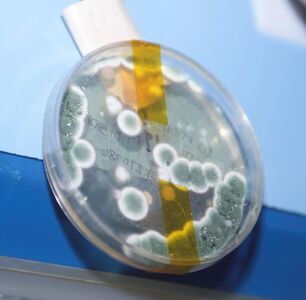Astrolisomyces Paranoosferos
Astrolisomyces paranoosferos is a fungus of the interspatial mycosphere, found exclusively in the vacuum of space. It is the only extant genus in the Astrolisomyces family. While it has rarely been known to process vegetable thanatomatter, it specialises in dead animals, having been detected both in gormagander remains and in corpses of virtually all species of spacefaring sentient beings.
Morphology and Lifecycle
Parasitism in A. paranoosferos
A. paranoosferos's spores are known to be psychoactive, inducing advanced states of paranoia, fear, or aggressiveness, when breathed by a sentient host. The effect is extremely rapid and its intensity can become overwhelming.
The rhizoids can grow inside of the body of the host only when it is dead, as they are generally easy to combat for a living immune system. The Deltan doctors Visineris and Terimn have conclusively shown[1] that the psychoactive effect of the spores is an evolutionary adaptation to ensure its life cycle: a ship-wide state of heightened paranoia and aggressiveness can often result in the self-destruction of the ship and the death of most of its inhabitants. The resulting collection the corpses is a perfect feeding and breeding ground for the dominator form of A. paranoosferos; the fungus can easily consume all organic matter and, when the hosts are completely processed, use its own biomass to create spores. The final phase of the process, where the body of the host disappears and is replaced by a porous fungine mass, is called the lisobloom. The spores are eroded from the lisobloom by the solar wind, and they can resist in the vacuum of space virtually forever, waiting to be picked up by a new starship and repeat its lifecycle.
Evolution
This evolutionary pathway is advantageous since few other fungi can so effectively process decomposing matter in the vacuum of space: A. paranoosferos can decompose the body without competition over years if not decades; its spores are equally devoid of competition or any sort of predation in the interspatial medium.
The Progenitor parasite hypothesis
The widespread capacity of A. paranoosferos to trigger similar neurological responses in very different species and brains suggests that the fungus, as a species, developed as a parasite of the Progenitor species[2]: the similarity in the response underlines a common feature in the Progenitor-descended sentient brain. The genetic code of A. paranoosferos has been sequenced and contains a mere 15'306 basis pairs. Phylogenetic analysis couldn't definitely settle the Progenitor origin conjecture[3].
Habitat and transport vector
While A. paranoosferos is known as a spacefaring lifeform, this is somewhat misleading, as only dormant spores can be found in space. Any other lifecycle -- the vanguard, the dominator, the lisobloom -- are always found on or in a host.
In most ships, contamination happens when spores of A. paranoosferos deposit on the hull to then getting carried by the boots of an EV suit, or enter directly when the hull is breached. Contamination via the transporter is virtually unknown. Likewise, A. paranoosferos doesn't survive on most planets, since methane is extremely poisonous to it and even the trace amounts in most atmospheres is enough to weaken any atmospheric spread nihil; therefore both its lichen-like growth and its lisobloom are extremely uncompetitive when compared to a biosphere's native fungi. That said, a starship's air filtration is usually efficient enough to keep methane low enough that A. paranoosferos can tolerate (this is generally due to methane's high chemical reactivity), although that depends on the species (Klingon starships being a good example of a high-methane standard). Flushing the ship's atmosphere with methane is generally sufficient to eliminate any contamination, be it vanguard or dominator, although this has no effect on the spores already in the system.
Astrolisomyces paranoosferos in the Federation
In the records of the Federation, about two ships per year are lost to an A. paranoosferos shipwide madness. A Starfleet team in 2281 developed a psychoactive compound that suppresses the paranoid response, acetodestroteraphtalbenzoic acid, that can be administered airborne and will be enough to calm the spirits[4].
